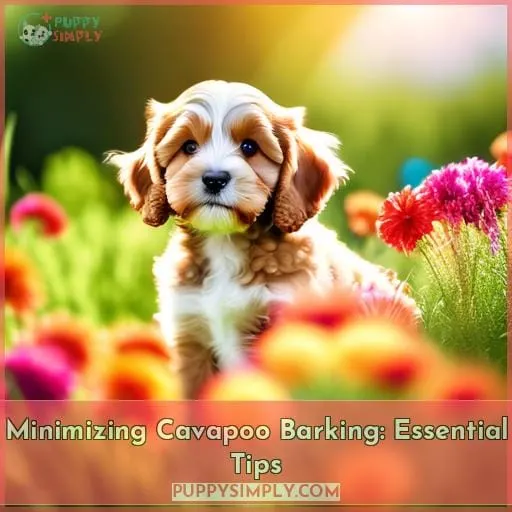This site is supported by our readers. We may earn a commission, at no cost to you, if you purchase through links.

These intelligent and friendly dogs have a lot to say, but excessive barking can be a problem.
Explore the reasons behind their vocalizations and learn effective strategies to curb this behavior.
With patience and consistency, you can teach your Cavapoo to communicate appropriately and enjoy a harmonious home.
Table Of Contents
- Key Takeaways
- Cavapoo Barking: a Deeper Dive
- Causes of Excessive Barking: Unraveling the Why
- Managing Cavapoo Barking: a Guide to Peace
- Barking Prevention: Techniques and Strategies
- Minimizing Cavapoo Barking: Essential Tips
- Training Cavapoos to Stop Barking: Step-by-Step
- Barking as Communication: Interpreting Your Cavapoo’s Woofs
- Health Factors Influencing Barking: When to Seek Help
- Cavapoo Barking Myths and Facts: Separating Truth From Fiction
- Frequently Asked Questions (FAQs)
- How can I differentiate between normal and excessive barking in my Cavapoo?
- What are some unique challenges in training Cavapoos to stop barking compared to other dog breeds?
- Are there any specific health conditions or medical issues that can contribute to excessive barking in Cavapoos?
- How can I create a more calming and less stimulating environment for my Cavapoo to reduce barking?
- Are there any breed-specific training techniques or approaches that are particularly effective for Cavapoos when it comes to barking control?
- Conclusion
Key Takeaways
- Cavapoo barking can stem from attention-seeking, alerting, stress, loneliness, or social barking. Effective behavior modification requires identifying the root cause.
- Provide ample exercise, mental stimulation, and an enriched environment to minimize excessive barking. Understand the context, tone, and duration of barks to identify the underlying cause.
- Prevent Cavapoo barking by identifying triggers and implementing behavioral modifications. Create an enriched environment and avoid using shock collars. Seek professional help if necessary.
- Train Cavapoos to stop barking by identifying behavioral triggers, teaching speak and quiet commands, providing interactive distractions, and engaging in regular playtime and exercise.
Cavapoo Barking: a Deeper Dive
Let’s dive into the complexities of Cavapoo barking, exploring the underlying causes and uncovering effective strategies for managing this common canine behavior.
Understanding the triggers behind your Cavapoo’s barking is the first step towards resolving the issue. Whether it’s separation anxiety, boredom, or a desire for attention, identifying the root cause will help you tailor a solution that truly addresses your dog’s needs.
Behavioral modifications and socialization techniques can effectively curb excessive barking. With consistency in training and positive reinforcement, you can teach your Cavapoo appropriate ways to communicate and express themselves.
Causes of Excessive Barking: Unraveling the Why
Let’s explore why your Cavapoo might be barking excessively.
Their barking can stem from:
- Attention-seeking
- Alerting to visitors or sounds
- Stress
- Loneliness
- Social barking triggered by other dogs
Identifying the root cause is the first step toward effectively addressing your Cavapoo’s barking behavior.
Barking Causes Identification
You’ll need to identify why your Cavapoo barks excessively to address the behavior effectively.
Watch for specific patterns and triggers:
- Is your dog anxious or stressed?
- Does it bark at certain people, animals, or objects?
- Are there environmental stimuli that set it off?
Recognizing these triggers is the first step toward developing a solution.
Effective Barking Deterrence
To effectively deter your Cavapoo’s barking, you’ll need to:
- Understand the underlying causes and address them appropriately.
- Employ training techniques to modify behavior and enrich your Cavapoo’s environment.
- Utilize positive reinforcement to reward desired behavior.
- Implement behavioral conditioning to discourage unwanted barking.
By understanding your Cavapoo’s needs and consistently applying these strategies, you can effectively deter excessive barking and promote a harmonious household.
**Bark Command Training
Teach your Cavapoo to bark on command, giving you control over their vocalizations.
This technique, coupled with positive reinforcement, establishes a clear communication channel.
With consistent training, your Cavapoo learns to express itself appropriately, reducing excessive barking and strengthening your bond.
Managing Cavapoo Barking: a Guide to Peace
Give your Cavapoo ample exercise and mental stimulation to minimize excessive barking.
Exercise not only releases pent-up energy but also strengthens your bond.
Engage your Cavapoo in activities that challenge their intellect like puzzle toys or interactive feeders.
Behavior modification involves teaching your Cavapoo appropriate behaviors to replace barking.
Reward them when they behave calmly, and gradually increase the duration between rewards to solidify the desired behavior.
Environmental enrichment involves creating a stimulating environment that caters to your Cavapoo’s natural instincts.
This includes providing them with interactive toys, hiding treats around the house, and taking them on daily walks to explore new sights and smells.
Vocalization analysis is key to understanding why your Cavapoo barks.
Pay attention to the context, tone, and duration of their barks to identify the underlying cause, whether it’s anxiety, boredom, or seeking attention.
Barking Prevention: Techniques and Strategies
Moving on to preventive measures, you can employ several techniques and strategies to stop your Cavapoo from barking excessively.
Begin by identifying the triggers that prompt your dog to bark. Whether it’s boredom, anxiety, or attention-seeking, understanding the cause is the first step to finding a solution.
Once you know the triggers, you can implement behavioral modifications, such as providing mental stimulation, adjusting routines, and utilizing positive reinforcement to reward desired behavior.
Additionally, creating an enriched environment with sight barriers, toys, and activities can help keep your Cavapoo occupied and reduce barking.
However, it’s crucial to avoid using shock collars, as they can cause psychological distress and exacerbate the problem.
By implementing these strategies consistently, you can effectively prevent excessive barking and enjoy a harmonious relationship with your beloved Cavapoo.
Minimizing Cavapoo Barking: Essential Tips
Now that you know how to prevent excessive barking, let’s delve into essential tips for minimizing your Cavapoo’s barking. Think of it as creating a harmonious symphony where your Cavapoo’s voice blends seamlessly into the background.
- Distraction Techniques:
When your Cavapoo starts barking, immediately divert their attention with a captivating toy or engaging activity. This simple trick can interrupt the barking cycle and redirect their focus.
- Mental Stimulation:
Keep your clever Cavapoo’s mind active with interactive toys, puzzle feeders, and challenging games. Mental stimulation helps curb boredom and reduces the likelihood of barking out of frustration.
- Environmental Enrichment:
Create a stimulating environment for your Cavapoo by providing a variety of toys, perches, and cozy spots to explore. A dynamic environment keeps them engaged and less prone to boredom-induced barking.
- Calming Techniques:
When your Cavapoo shows signs of anxiety or stress, offer soothing techniques like gentle抚摸, calming music, or a relaxing massage. These techniques help ease their worries and minimize stress-related barking.
- Exercise Regimen:
Ensure your Cavapoo receives adequate daily exercise to burn off excess energy and promote relaxation. A tired Cavapoo is less likely to bark excessively.
Training Cavapoos to Stop Barking: Step-by-Step
With persistence and positive reinforcement, training your Cavapoo to curb excessive barking involves establishing clear commands and consistent routines.
Begin by identifying your Cavapoo’s behavioral triggers. Are they barking out of boredom, anxiety, or a health issue? Once you understand the cause, you can start implementing strategies to address it.
Teach your Cavapoo the speak and quiet commands. Use positive reinforcement and treats to reward desired behavior. When your Cavapoo barks excessively, firmly say quiet and offer a treat when they comply.
Provide interactive distractions to keep your Cavapoo occupied and mentally stimulated.
Consider seeking professional help from a veterinarian or animal behaviorist if health-related issues or severe anxiety are the root of the barking problem.
Barking as Communication: Interpreting Your Cavapoo’s Woofs
Your Cavapoo’s barks convey a range of emotions, so pay attention to their pitch, volume, and context.
A high-pitched, sharp bark often signals excitement or anxiety, while a low, deep bark can indicate a warning or territorial defense.
Short, repetitive barks may express frustration or boredom, while prolonged barking could be a sign of loneliness or distress.
Learn to recognize these cues to better understand your Cavapoo’s needs and respond appropriately.
Socializing your Cavapoo from an early age can help reduce barking triggered by fear or anxiety around strangers or other animals.
Regular vet check-ups are crucial to rule out any underlying health issues that may cause excessive barking.
Health Factors Influencing Barking: When to Seek Help
As a responsible pet owner, you should pay attention to any changes in your Cavapoo’s barking habits.
If you notice excessive barking, especially if it’s accompanied by other symptoms like lethargy or loss of appetite, it’s crucial to seek veterinary assistance promptly.
Early detection and treatment of underlying health issues can help prevent more severe problems and restore your Cavapoo’s normal behavior.
Health Checks Regularly
Taking your Cavapoo for regular vet checkups can reveal underlying health issues that trigger excessive barking.
Don’t let health concerns go unnoticed. Veterinary care is crucial for your Cavapoo’s well-being.
Early detection of health issues can prevent minor ailments from escalating into severe problems.
Preventive measures, like regular checkups, ensure your Cavapoo’s holistic health, minimizing the likelihood of excessive barking due to discomfort.
Veterinary Care Crucial
You should visit the vet if you notice any changes in your Cavapoo’s barking habits, as they could be signs of underlying health issues that need attention.
Regular checkups with your vet are crucial for detecting and addressing any medical problems that may be causing excessive barking.
Your vet can also provide guidance on proper nutrition, exercise, grooming, behavioral enrichment, and training techniques to help manage your Cavapoo’s barking.
Early Detection Matters
Watch out for changes in your Cavapoo’s barking, as they can signal underlying health issues that need attention.
Early detection is crucial to ensure prompt treatment and prevent further complications.
Be vigilant and take your Cavapoo for regular checkups to catch any health issues that may be influencing their barking behavior.
These checkups can help identify and address potential health concerns before they escalate.
Cavapoo Barking Myths and Facts: Separating Truth From Fiction
Discover the truth about Cavapoo barking by separating fact from fiction.
Uncover the myths and misconceptions surrounding this vocal breed.
While Cavapoos are generally well-behaved, understanding their barking tendencies can help you address excessive noise.
Learn about common behavioral insights and gain valuable training tips to effectively manage your Cavapoo’s barking.
Explore the truth behind myths like:
- Cavapoos bark incessantly.
- Training is ineffective for Cavapoos.
Discover how to interpret your Cavapoo’s unique communication signs and address underlying causes of excessive barking.
Gain clarity on the effectiveness of training methods and dispel common misconceptions about Cavapoo behavior.
Frequently Asked Questions (FAQs)
How can I differentiate between normal and excessive barking in my Cavapoo?
To discern normal from excessive barking, monitor your Cavapoo’s behavior and context.
Normal barking serves a purpose, like alerting you or expressing excitement.
Excessive barking may indicate distress, anxiety, or boredom.
What are some unique challenges in training Cavapoos to stop barking compared to other dog breeds?
Cavapoos’ strong attachment to their owners can make them prone to separation anxiety, leading to excessive barking when left alone.
Their intelligence also means they require consistent training to curb barking habits.
Are there any specific health conditions or medical issues that can contribute to excessive barking in Cavapoos?
Health conditions like thyroid issues or allergies can cause discomfort, leading to increased barking in Cavapoos.
Regular vet checkups help detect and manage these conditions, reducing excessive barking.
How can I create a more calming and less stimulating environment for my Cavapoo to reduce barking?
Craft a calming sanctuary for your Cavapoo by:
- Minimizing external stimuli.
- Providing comfortable resting areas.
- Employing calming scents or music.
Create a tranquil atmosphere that discourages excessive barking.
Are there any breed-specific training techniques or approaches that are particularly effective for Cavapoos when it comes to barking control?
To tame your Cavapoo’s vocal nature, leverage their innate intelligence with positive reinforcement.
This breed thrives on praise, making it a snap to shape their behavior.
Conclusion
Overcome the barking bedlam with Cavapoos by understanding their vocal quirks and implementing effective training strategies.
With patience, consistency, and the right techniques, you can transform your once yappy pup into a peaceful companion.















